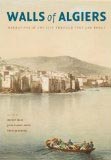Maritime Nations
° Algiers ° Annaba ° Arzew ° Bejaia ° Djendjene ° Jijel ° Mostaganem ° Oran ° Skikda
Algeria
The name Algeria (in Northern Africa) is derived from the name of the country's oldest continuous settlement and modern capital, Algiers, a strategically located port city with access to both Europe and the Middle East.
March 11, 1854, Weekly News and Chronicle, London, United Kingdom
Study for the painting "Women of Algiers."
Eugene Delacroix.

The Kabyles may be said to form the first strata of the Algerian population; the Arabs, who probably drove them from the plains into the mountains, always the last refuge of the aborigines of a country form the second, and still occupy the position which the superiority of their cavalry won for them in the eighth century. On the subject of this interesting race our author's pages also contain much valuable information, for which we must refer our readers to the book itself. We cannot, however, take leave of this without finding room for one of those legends to which the Arab loves to listen, and which generally embody an amount of wisdom which ought not to be lost on the European mind either. The present legend owes its origin to Sidi-Mohamed-ou-Altai:
One day Sidna-Aissa (our Lord Jesus Christ) met Chaytan (Satan), who was driving four asses before him, heavily laden, and said to him : "Chiaytan, why, thou art become a merchant, then?" " Yes, Lord; and I've so much business on hand, that I cannot do justice to it."
"What business do you carry on, then?" "Lord, an excellent business; just see. One of these asses and I choose them amongst the strongest in Syria is laden with injustices; who will buy them of me? the sultans. The second ass is laden with envies; who will buy them of me? the learned. The third is charged with thefts; who will purchase them? the merchants. The fourth carries, together with perfidies and wiles, an assortment of seductions, which are related to all the vices; who will buy them? the women."
"Wicked one, may God curse thee!" replied Sidna-Aissa "What is that to me, if I gain?" replied Chaytan.
The next day Sidna-Aissa, who was saying his prayers at the same spot, was disturbed by the swearing of a donkey driver, whose four asses, overwhelmed by their load, refused to go on; and he recognised Chayan by their load. "Thank God! Thou hast sold nothing," he said, addressing him. "Lord, an hour after you left me, all my panniers were empty but, as usual, I had difficulties about the payment."
"The Sultan caused me to be paid through his khalifa, who wanted to cheat me about the sum. The sages said they were poor. The merchants and I called each other thieves. The women alone paid me handsomely, without bargaining."
"And yet 1 see thy panniers still full," objected Sidna-Aissa. "They are full of money; and I am carrying it to the kadi (to justice)," replied Chaytan, driving on his assess. "O my brothers," added Sidi-Mouamed-ou-Allal, "the free man, it he is grasping, is a slave; the slave is free, if he lives on little. Choose tents to repose in, and for your last dwelling the cemeteries. Nourish yourselves with the produce of the earth, satisfy your thirst with the running water, and you will leave the world in peace."
Algeria borders Tunisia and Libya to the east, Niger, Mali, and Mauritania to the south; Morocco and Western Sahara to the west, and the Mediterranean Sea to the north. Algeria is the second largest country in Africa (after Sudan), and the 11th largest in the world.
While the majority of the population who are Arab (or mixed Arab and Berber) identify with the common Algerian culture, the Berber tribes, particularly in the more isolated southern mountainous and desert regions, retain more of the indigenous Berber culture and identity.
Algeria. Carte de L'Algerie. Malte-Brun. 1852

As early as 1200 B.C.E., the Phoenicians invaded the Berber tribes of the area and began establishing ports along the Mediterranean. By 1510, Spain had seized important port cities such as Algiers and Oran. Ruins throughout the country include cave paintings, traces of Phoenicians, Roman ruins, remnants from the Ottoman Empire, the Spanish, Arabs, and the French, who invaded Algeria on June 14, 1830 with more than 600 French ships carrying 37,000 men and ruled through 1962.
July 17, 1830, Baldwins London Weekly Journal
FALL OF ALGIERS.
Algiers has fallen. It surrendered without a blow to Count Bourmont on the 5th inst. A report of this event reached town on Saturday. Some doubts were cast upon its truth, in consequence of the slovenly manner in which it was communicated from Calais, in a telegraphic despatch, half French and half English; but we have received by estafette the full confirmation of this important event, with some of its principal details , which are as follows:
On Friday, at two o'clock, the French Minister of Marine received by telegraph a despatch from Toulon, announcing the surrender of Algiers. The following is a copy:
"Toulon, July 9, Half-past ten o'clock a.m. "Algiers surrendered at discretion on the 5th instant at twelve o'clock. At two the King's flag waved over the palace of the Dey. All our shipwrecked prisoners are safe."
Landing of the French in Algeria, 1830After completing his research for Democracy in America, Alexis de Tocqueville turned to the French consolidation of its empire in North Africa, which he believed deserving of similar attention. Tocqueville began studying Algerian history and culture, making two trips to Algeria in 1841 and 1846. He quickly became one of France's foremost experts on the country and wrote essays, articles, official letters, and parliamentary reports on such diverse topics as France's military and administrative policies in North Africa, the people of the Maghrib, his own travels in Algeria, and the practice of Islam. Throughout, Tocqueville consistently defended the French imperial project, a position that stands in tension with his admiration for the benefits of democracy he witnessed in America. Although Tocqueville never published a book-length study of French North Africa, his various writings on the subject provide as invaluable a portrait of French imperialism as Democracy in America does of the Early Republic period in American history. In Writings on Empire and Slavery, Jennifer Pitts has selected and translated nine of his most important dispatches on Algeria, which offer startling new insights into both Tocqueville's political thought and French liberalism's attitudes toward the political, military, and moral aspects of France's colonial expansion. The volume also includes six articles Tocqueville wrote during the same period calling for the emancipation of slaves in France's Caribbean colonies. |
Our Parisian correspondent says that "the bulletin was immediately forwarded to the Bourse, and to other public offices, as well as to the Opera and French theatres. Everywhere it was received with delight; and although it contained nothing more than the mere fact of the surrender, yet every where the cries of 'Vive le Roi' were to be heard from all classes of the people. At the Bourse, indeed, the effect produced was not so great as was anticipated, and the funds, which suddenly rose, afterwards as suddenly fell. There is no use in concealing from one's self that the reason for this was, that the jobbers felt that the surrender of Algiers would add to the power of the existing administration, and render their continuance in office yet more certain."
Dey Hussein Ibn El Hussein Leaving Algiers after the City has been captured on July 4, 1830

After the above bulletin had been received, another followed later in the afternoon, of which the following is a copy:--
"In continuance of my despatch of this morning, I have to announce that 1,500 pieces of brass cannon, 12 ships of war, and the military and naval arsenals, stored with arms and ammunition, fell into our hands on this memorable day. I received these details from the captain of the Sphynx, who left Algiers on the evening of the 5th, and has just arrived."
We were fully prepared for this event, and persist in our opinion that it is a triumph to civilization, for which we ought to rejoice. We hope that the Barbary powers will be wholly crushed, and for ever; -- it was a disgrace to Europe that they continued to exist so long. As for the exclusive advantage to be derived by France from the conquest we do not care about it; the French have never been successful in colonization, nor is the territory which their arms may win an unpeopled waste for them to manage without opposition.
Fantasia Algiers. 1881. Auguste Renoir.

Napoleon III visited Algeria twice in the early 1860s. He was iimpressed with the nobility and virtue of the tribal chieftains, who appealed to the emperor's romantic nature, and was shocked by the self-serving attitude of the colon leaders.
He determined to halt the expansion of European settlement beyond the coastal zone and to restrict contact between Muslims and the colons, whom he considered to have a corrupting influence on the indigenous population. He envisioned a grand design for preserving most of Algeria for the Muslims by founding a royaume arabe (Arab kingdom) with himself as the roi des Arabes (king of the Arabs). He instituted the so-called politics of the grands chefs to deal with the Muslims directly through their traditional leaders.
The Arrival of Napoleon III in Algeria with an escort of Battleships. May 1, 1865 Louis Le Breton Louis Le Breton (1818 Douarnenez 1866) was a French painter who specialised in marine paintings. Le Breton studied medicine and took part in Dumont d'Urville's second voyage aboard the Astrolabe. After the official illustrator of the expedition died, Le Breton replaced him. From 1847 he devoted himself exclusively to depicting marine subjects for the French Navy. Louis Le Breton travelled with Dumont d'Urville's expedition to the South Pole and Oceania from 1837 to 1840. From 1845-1847 he was part of an expedition to Madagascar. He produced tinted lithographs and chromolithographs on naval forces, ships and boats, sea landscapes and ports. After 1847, he devoted himself to depicting marine subjects for the French Navy such as the image above. |

Napoleon III visualized three distinct Algerias: a French colony, an Arab country, and a military camp, each with a distinct form of local government. The second decree, issued in 1865, was designed to recognize the differences in cultural background of the French and the Muslims. As French nationals, Muslims could serve on equal terms in the French armed forces and civil service and could migrate to metropolitan France. They were also granted the protection of French law while retaining the right to adhere to Islamic law in litigation concerning their personal status. But if Muslims wished to become full citizens, they had to accept the full jurisdiction of the French legal code, including laws affecting marriage and inheritance, and reject the competence of the religious courts. In effect, this meant that a Muslim had to renounce his religion in order to become a French citizen. This condition was bitterly resented by Muslims, for whom the only road to political equality became apostasy. Over the next century, fewer than 3,000 Muslims chose to cross the barrier and become French citizens.
When the Prussians captured Napoleon III at the Battle of Sedan (1870), ending the Second Empire, the colons in Algiers toppled the military government and installed a civilian administration.
May 13, 1865, Illustrated Times, London, Middlesex, United Kingdom THE ILLUSTRATED TIMES Illustrative of Incidents connected with the |
Bejaia
Bejaia on the north coast of Algeria, was once a hub of the Mediteranian trading extensively with many places including Pisa. The settlement which later became the town of Béjaïa was originally founded by Numidian Berbers. The town later served as a port in the Carthaginian and Roman eras gaining importance under Roman Emperor Vespasian as a gateway to Mauretania.
For a short while Béjaïa was the capital city of the kingdom formed by Germanic Vandals, who were conquered and replaced by the Byzantines in around 533 AD. This kingdom gave way to the Berber Hammadid dynasty, with Béjaïa serving as the capital city, commercial and cultural center. At that time Béjaïa was named En Nassria by the Hammadid leader Emir En Nasser. Construction work at the time included fortifications and a palace.
In 1152 the Hammadid Empire fell to the Almohad ruler Abd al-Mu’min who invaded the area from his base in Morocco. By the 13th century, Béjaïa was in the possession of the Hafsid Empire, and by the early 16th century was under control of Spain (1510-1555) before being taken over by the Ottoman Turks. At this time the Barbary Pirates dominated the coastline that came to be known as the Barbary Coast – the middle and western coastal regions of North Africa, including Morocco, Algeria, Libya and Tunisia. Béjaïa was a stronghold of the Barbary Pirates until the town was captured by the French in 1833, later gaining independence along with the rest of Algeria.
Women of Algiers. 1834. Eugene Delacroix.

Bejaia, Al-Idrisi wrote: '[It] is the capital of the Banu Hammad, ships unload there, caravans come to it by land and it is a depot for merchandise. The merchants of this town trade with those of Western Africa as well as with those of the Sahara and east, merchandises of all sorts may be found here. The surrounding mountains and valleys are well wooded and produce resin and tar of excellent quality so that large ships for war and commerce are built here.
1899. World's Fleet. Boston Daily Globe
Lloyds Register of Shipping gives the entire fleet of the world as 28,180 steamers and sailing vessels, with a total tonnage of 27,673,628, of which 39 perent are British.
| Great Britain | 10,990 vessels, total tonnage of 10,792,714 |
| United States | 3,010 vessels, total tonnage of 2,405,887 |
| Norway | 2,528 vessels, tonnage of 1,604,230 |
| Germany | 1,676 vessels, with a tonnage of 2,453,334, in which are included her particularly large ships. |
| Sweden | 1,408 vessels with a tonnage of 643, 527 |
| Italy | 1,150 vessels |
| France | 1,182 vessels |
For Historical Comparison
Top 10 Maritime Nations Ranked by Value (2017)
| Country | # of Vessels | Gross Tonnage (m) |
Total Value (USDbn) |
|
|---|---|---|---|---|
| 1 | Greece | 4,453 | 206.47 | $88.0 |
| 2 | Japan | 4,317 | 150.26 | $79.8 |
| 3 | China | 4,938 | 159.71 | $71.7 |
| 4 | USA | 2,399 | 55.92 | $46.5 |
| 5 | Singapore | 2,662 | 64.03 | $41.7 |
| 6 | Norway | 1,668 | 39.68 | $41.1 |
| 7 | Germany | 2,923 | 81.17 | $30.3 |
| 8 | UK | 883 | 28.78 | $24.3 |
| 9 | Denmark | 1,040 | 36.17 | $23.4 |
| 10 | South Korea | 1,484 | 49.88 | $20.1 |
| Total | 26,767 | 87.21 | $466.9 | |







 Copyright ~ 1998-2018.
Copyright ~ 1998-2018. 